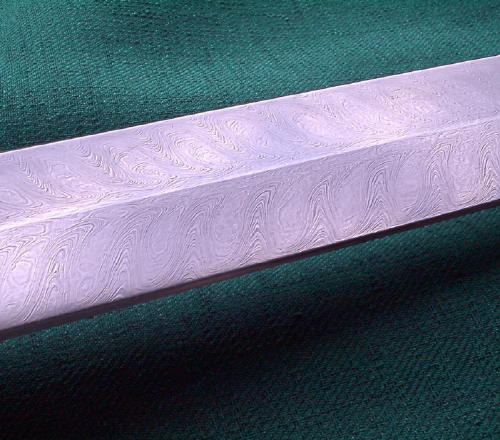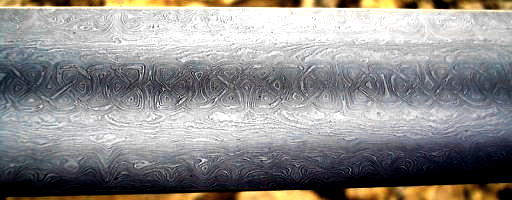
More of my wootz:
 Attachment: 52.41 KB
Attachment: 52.41 KB


Daniel, thanks for your explanations re: Damascus blades, and especially for the close-up photo of wootz steel. Beautiful!
Daniel, thanks for your explanations re: Damascus blades, and especially for the close-up photo of wootz steel. Beautiful!
Hi
I haven't tried the " silk " test on any of my blades... (partly cause I don't own any silk.. lol).. most of my wootz gets the traditional chop tests... ( full bore chops on a 2by4 )
and a pseudo reed mat..... actually a roll of cardboard tightly coiled..
wootz bowies that I've tested... when they have a nice coarse pattern really show up well in cut tests.... specially with a slight draw towards your self while striking the target...
personally... I'd hate to say one is superior than the other... because I do love wootz steel and I have a bias towards it...therefore I cannot say I'm impartial
Hi Daniel
hey ..hows about giving us a hint on your pattern formation on that wootz... I'd like to hear your special formula...
( ha ha.... I know ... I know.... top secret for now )
maybe in a couple weeks.... when the snow clears up.... I'm gonna try making some bulat..... I've got some ideas on that...
- have you used any cobalt and tungsten in your melts?
take care
Greg
I haven't tried the " silk " test on any of my blades... (partly cause I don't own any silk.. lol).. most of my wootz gets the traditional chop tests... ( full bore chops on a 2by4 )
and a pseudo reed mat..... actually a roll of cardboard tightly coiled..
wootz bowies that I've tested... when they have a nice coarse pattern really show up well in cut tests.... specially with a slight draw towards your self while striking the target...
personally... I'd hate to say one is superior than the other... because I do love wootz steel and I have a bias towards it...therefore I cannot say I'm impartial
Hi Daniel
hey ..hows about giving us a hint on your pattern formation on that wootz... I'd like to hear your special formula...
( ha ha.... I know ... I know.... top secret for now )
maybe in a couple weeks.... when the snow clears up.... I'm gonna try making some bulat..... I've got some ideas on that...
- have you used any cobalt and tungsten in your melts?
take care
Greg
Daniel, Jörg, thank you both very much. You've been icredibly helpful.
Greg, from what I've been able to pick up through Google links, wootz is possibly one of the best materials for cutting flesh because of the saw-like edge the different particles create -but this also makes it less effective against other materials, such as wood(hence it wouldn't make for a very good axe).
Greg, from what I've been able to pick up through Google links, wootz is possibly one of the best materials for cutting flesh because of the saw-like edge the different particles create -but this also makes it less effective against other materials, such as wood(hence it wouldn't make for a very good axe).
Josh,
I believe the confusion over fullers and stiffness is due to assuming you start with two blades of the same dimensions
and then put a fuller in one. There is *some* theory that a small amount of added stiffness would come from the
circular shape of the cross section, but I don't believe that is significant (can anyone give better data?)
On the other hand, a fuller is usually applied to a blade that has been designed assuming a fuller would be added to
reduce the weight, bringing it back to the weight of a non-fullered blade. If you look at many blades and their stats, the
ones with fullers don't usually weigh less - they weigh about the same. Thus, such a blade was built with a thicker
spine, and THEN a fuller removed the excess weight. This, the fuller *allows* a heavier spine, and from THAT we
get a stiffer blade.
So I believe the more correct explanation is that a blade with a fuller is stiffer than one of similar weight without a
fuller. Of course, not all replicas built today use that design feature this way, but the better ones seem to. For
example the AT's, A & A's, Albions, etc. all seems to have their swords deisgned where the fuller allows a larger
spine.
There are other features of blade design worth considering. For example, using a fuller (particularly a broad one)
moves more of the metal out to the edges of the blade. This design is similar to that used in an I-beam or even a
good old cresent wench - extra material around the peripery, less in the interior. This actually makes the blade
stronger in the face of lateral forces (when cutting) - again assuming you have the same amount of metal (and weight)
overall in blades with and without this feature.
So, yes, a fuller reduces weight, but not to get a lighter sword, but to allow you to put the material where it is needed
most to strengthen the blade.
That said, all my swords are diamond shaped! (go figure!)
Walt
I believe the confusion over fullers and stiffness is due to assuming you start with two blades of the same dimensions
and then put a fuller in one. There is *some* theory that a small amount of added stiffness would come from the
circular shape of the cross section, but I don't believe that is significant (can anyone give better data?)
On the other hand, a fuller is usually applied to a blade that has been designed assuming a fuller would be added to
reduce the weight, bringing it back to the weight of a non-fullered blade. If you look at many blades and their stats, the
ones with fullers don't usually weigh less - they weigh about the same. Thus, such a blade was built with a thicker
spine, and THEN a fuller removed the excess weight. This, the fuller *allows* a heavier spine, and from THAT we
get a stiffer blade.
So I believe the more correct explanation is that a blade with a fuller is stiffer than one of similar weight without a
fuller. Of course, not all replicas built today use that design feature this way, but the better ones seem to. For
example the AT's, A & A's, Albions, etc. all seems to have their swords deisgned where the fuller allows a larger
spine.
There are other features of blade design worth considering. For example, using a fuller (particularly a broad one)
moves more of the metal out to the edges of the blade. This design is similar to that used in an I-beam or even a
good old cresent wench - extra material around the peripery, less in the interior. This actually makes the blade
stronger in the face of lateral forces (when cutting) - again assuming you have the same amount of metal (and weight)
overall in blades with and without this feature.
So, yes, a fuller reduces weight, but not to get a lighter sword, but to allow you to put the material where it is needed
most to strengthen the blade.
That said, all my swords are diamond shaped! (go figure!)
Walt
| Josh S. wrote: |
| Daniel, Jörg, thank you both very much. You've been icredibly helpful.
Greg, from what I've been able to pick up through Google links, wootz is possibly one of the best materials for cutting flesh because of the saw-like edge the different particles create -but this also makes it less effective against other materials, such as wood(hence it wouldn't make for a very good axe). |
How well Wootz does against wood or other materials is related to the matrix in which the carbides form. This can be just as good (or bad) as any other steel.
Daniel
| Quote: |
| I believe the confusion over fullers and stiffness is due to assuming you start with two blades of the same dimensions and then put a fuller in one. |
Yes, that's correct... Actually, I had just figured this out a couple of days ago. I could already see how the fuller would increase strength in the horizontal plane(as in a cut), but it seemed it would decrease the strength in the lateral plane(as in flexing the blade). Then it occurred to me that the two blades would not be made of the same dimensions, but rather the same mass distributed differently to form different dimensions. In the case of a lenticular cross-section, especially, I can see how a fuller would actually add to the blade's stiffness -although a lenticular CS without fullers does more closely resemble a hollow-ground diamond, it would be less stiff than a lenticular CS of the same dimensions(and less weight) with a fuller(or, especially, a double fuller) -by virtue of the fact that the unfullered blade would weigh more, thereby causing gravity to pull more strongly at the blade. If the two blades were of the same weight, but the unfullered one of smaller dimensions, then I imagine the stiffness would most likely be identical(or close enough to it).
To simplify: first one must imagine a 5-foot iron rod with a square cross-section of 1-inch. This rod would be bent fairly easily, by applying force perpendicular to the cross-section's faces. Now, if the mass were to be distributed into a rod of the same length, but with a cross-section of a plus sign(+), it would be much more difficult to bend along the planes than the original rod would be. Since an I-beam's cross section more closely resembles that of the +, it's also more difficult to bend than a simple beam of the same weight.
Daniel, all of the other pictures of wootz steel I've seen were fairly low quality, but the coloration in them was still good. Why are your blades so light-colored in comparison to the others I've seen(they seem to be almost black & white).
[quote="Josh S."]
That is just a matter of finish. If I etch, then darken, and hand rub the highlights, I can get exactly the same look. However I prefer to use the look that I have seen on several antique blades where the wootz shimmers almost like a hologram. It doesn't photograph as well however.
Daniel
 Attachment: 27.12 KB
Attachment: 27.12 KB

| Quote: |
| Daniel, all of the other pictures of wootz steel I've seen were fairly low quality, but the coloration in them was still good. Why are your blades so light-colored in comparison to the others I've seen(they seem to be almost black & white). |
That is just a matter of finish. If I etch, then darken, and hand rub the highlights, I can get exactly the same look. However I prefer to use the look that I have seen on several antique blades where the wootz shimmers almost like a hologram. It doesn't photograph as well however.
Daniel

Page 2 of 2
You cannot post new topics in this forumYou cannot reply to topics in this forum
You cannot edit your posts in this forum
You cannot delete your posts in this forum
You cannot vote in polls in this forum
You cannot attach files in this forum
You can download files in this forum
All contents © Copyright 2003-2006 myArmoury.com — All rights reserved
Discussion forums powered by phpBB © The phpBB Group
Switch to the Full-featured Version of the forum
Discussion forums powered by phpBB © The phpBB Group
Switch to the Full-featured Version of the forum